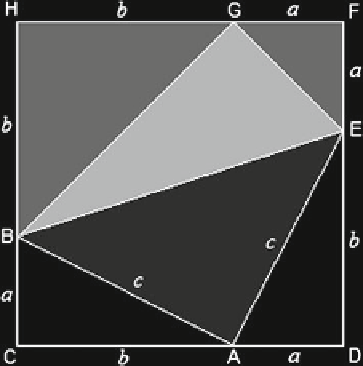Information Technology Reference
In-Depth Information
Fig. 18.4
Proof #64 in [
1
]
the Pythagorean one!). For the same reason, triangle
EFG
ha
s
are
a
a
2
/
2, and
2. Finally, triangle
GEB
has area
√
2
a
√
2
b
triangle
GHB
has area
b
2
ab
.
Now, the quadrilaterals
BC DE
and
EFHB
are equal (as trapezoids with
equal bases and altitude). So, adding the triangles they are made of we have:
ab
/
/
2
=
c
2
a
2
b
2
/
2
+
ab
/
2
+
/
2
=
/
2
+
/
2
+
ab
, which yields the sought for relation:
c
2
b
2
.
We observe now that all three proofs (#59, #60, and #64) use Socrates' Theorem
at some point in their arguments. Thus, the latter is a recurring theme. It is desir-
able that such recurring themes be identified as potentially important, as they can
prove useful in any nontrivial task or sub-task. The question is how to make the
system be of any help in this identification.
Recall that codelets are transient, but tasks are more permanent. Thus, if the sys-
tem keeps tasks in a repository, special codelets could be generated with the sole
purpose of identifying recurring tasks. This identification could bemediated semi-
automatically, if the tasks are codified somehow and then allowed to form groups
(categories) automatically based on their properties; alternatively (or: addition-
ally), human agents might help in this identification. Thus, identified recurring
tasks can receive an “activation” by the system, so that repeated tasks will stand
out, and this will help in their reuse when they appear again as components of
codelets in the system.
a
2
=
+
3.
might be asked to propose what
A
3
thinks is a simple “trigonometric
proof”, i.e., a proof expressed in trigonometric language, and create only the
public subtask of verifying the correctness of the proof.
The existence of trigonometric proofs sounds suspicious at first thought, because
the Pythagorean Theorem asserts that in a triangle
ABC
the equality sin
2
A
3
,
PT
3
(
A
)
+
sin
2
1 is equivalent to the angle
C
being right. In reality, any trigonometric
“proof” of the theorem that relies on the basic identity sin
2
(
B
)
=
cos
2
1
must be circular, and thus invalid. Indeed, remark 8 in [
1
] points to a page with
an incorrect proof (“false proof #4”), which proceeds as follows: as usual, let
(
x
)
+
(
x
)
=

Search WWH ::

Custom Search